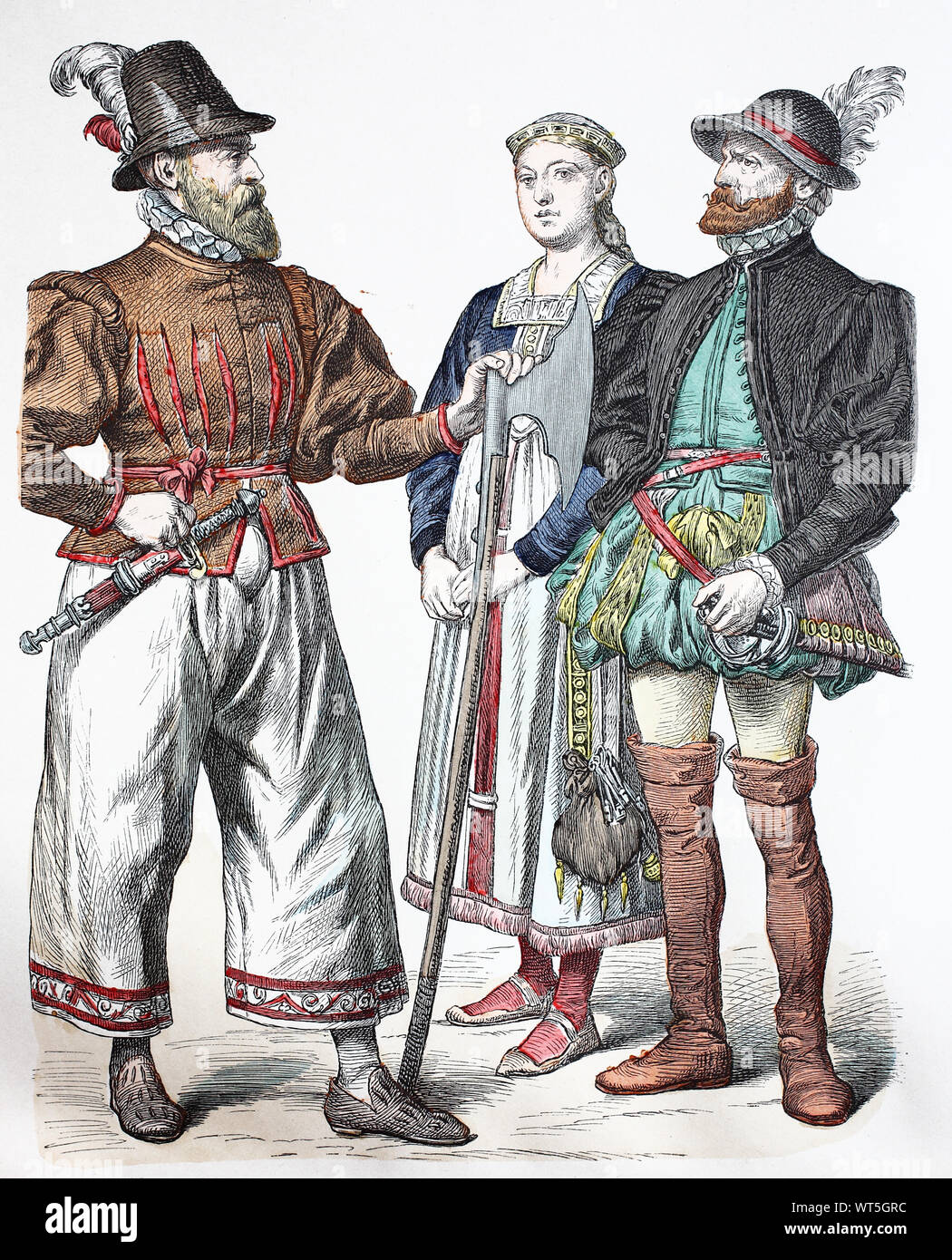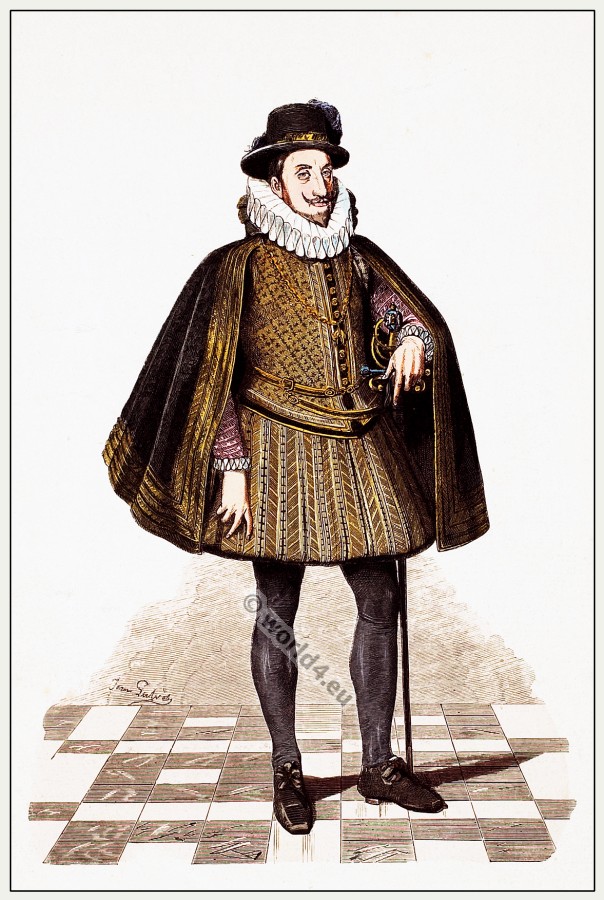
Germany and Japan in the 16th century Renaissance clothing
1550-1600 in European fashion English opulence, Italian reticella lace ruff, (possibly) Polish ornamentation, a French farthingale, and Spanish severity: The "Ermine Portrait" of Elizabeth I Fashion in the period 1550-1600 in European clothing was characterized by increased opulence.

15th c. German School Portrait Man Red Chalk Costume Renaissance
October 2004 At the turn of the fifteenth to the sixteenth century, one of the most startling changes in taste and fashion occurred, which was immediately mirrored in armor and can best be witnessed in the German harness of the period.

late 16th Century XVI German armoured citizen and citizeness Stock
Queen Elizabeth of England, showing the queen adorned in Renaissance fashion with pearl choker and pendant and a series of longer necklaces, portrait in oil by an unknown English artist, 16th century; in the Pitti Palace, Florence. (more)

Мода эпохи возрождения, Средневековая одежда, Историческое платье
European renaissance. Costume examples focusing on France, England, Germany and Italy in the 16th century. Clothing of the aristocracy, the military, citizens and peasants. Great changes now developed. The costumes for men and women from this time on are no longer alike. The desire now seemed to be to alter in various ways the normal shape of.

€ 33.00 16th cent. Early 16th to early 17th century Pontormo
Men's dress at the beginning of the fifteenth century was in all essentials similar to that which they had worn at the end of the previous century, but the character of the separate items had undergone considerable change owing to incongruous combinations and degenerations in shape.

Planning the Next Hunt by ColonelLiamRoss on deviantART 16th century
Since the 16th century, two types of traditional country dress developed: work clothes and Sunday/festive dress. The best examples of these styles are native dress (Tracht) and folk-style dress (Dirndl). A dirndl is a type of traditional dress worn in Germany - especially Bavaria - Switzerland, Liechtenstein, Austria and South Tyrol, based.

16th Century Cranach Princess Dress 16th Century German Costuming
German townswomen of the Reformation period. Late Renaissance costumes. German patrician women. First third of the 16th century. Source: Münchener Bilderbogen 1848 bis 1898. On the history of costumes. Published by Braun & Schneider. Royal Court and University Printing Office of Dr. C. Wolf & Sohn in Munich. On the history of costumes.

Friesland Costumes 16th Century. Traditional Medieval clothing. German
'Ready To Wear' Explores St. Louis Fashion — From Early Fur Trade, To Shoe Empires, To Invention Of Juniors By Evie Hemphill. Published May 25, 2021 at 5:16 PM CDT Listen • 21:27. While the fur trade in St. Louis had declined by the latter half of the 20th century, Kienzle noted that "there is a secret place" where locals and.

Attire's Mind 16th century clothing, 16th century fashion, 17th
Elizabeth of York, late 16th century, based on a work of circa 1500. Oil on panel; 56.5 x 41.6 cm (22 1/4 x 16 3/8 in). London: National Portrait Gallery, NPG 311. Source: National Portrait Gallery In England

German Renaissance aristocracy costume. Franz Lipperheide. 16th century
Top 10 Best Vintage Clothing in Saint Louis, MO - January 2024 - Yelp - The Vintage Haberdashery, Reset Vintage Apparel, Retro 101, Found Vintage - S Grand, The Green Shag Market, The Vault Luxury Resale, May's Place, Avalon Exchange, Get the WORD Out, Max and Moo's Thrift.

IMG_0839.jpg German outfit, 16th century fashion, Renaissance clothing
Fig. 230. 231. German women`s costumes, first half of the 15th century. The over-dress was like the under-dress, except that it was laced at the back. It was very long (and became longer about the middle of the century), and was low-necked, although at the beginning of the century the neck had been high. The width varied.

German headdress, late 15th century to early 16th century Medieval Garb
Oil on canvas; (48 x 37 3/4 in). Indianapolis Museum of Art, 2016.162. The Clowes Collection. Source: IMA Fig. 5 - Maker unknown (English). The Gatacre Jewel; The Fair Maid of Gatacre, ca. 1560. Amethyst, mounted in enamelled gold, and hung with pearls; 6.9 x 3.9 cm. London: Victoria and Albert Museum, M.7-1982.

16th century costume and fashion history. European renaissance
While at the start of the 1540s one still found the fuller sleeves worn in the 1530s closed with aiguillettes, like those seen on the unknown woman in a ca. 1540 Holbein portrait (Fig. 1), the silhouette of the decade would soon become dominated by the Spanish farthingale.

Enorme Matchmaker Härte friesen kostüm Extra Verbreitung Herzog
In this material, we'll unveil some curious facts about European 16th-century male clothes, show you a nice modern reproduction of that period's attire, and introduce you to the secrets of German Renaissance men's clothing, with all its peculiarities. Read also: Aristocratic menswear in the 16th century.

Pin by Yin on Adam’s family 16th century fashion, Renaissance
Introduction to 16th century German Costuming Inspriation - Online Art Research Thanks to the Internet, there is now a large amount of artwork easily available, and its getting better organized all the time. I find portraits and etchings of real people to be the most inspiring sources for costuming.

Spanish court dress. German Emperor Ferdinand II.
The second decade of the 16th century featured broad-shouldered silhouettes for men and women, paired with immense sleeves (except for women in Germany, who retained narrow sleeves). Slashing, pinking, paning and other decorative fabric treatments like blackwork embroidery were increasingly common. Womenswear